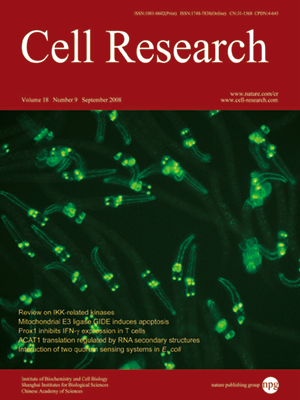
Volume 18, No 9, Sep 2008
ISSN: 1001-0602
EISSN: 1748-7838 2018
impact factor 17.848*
(Clarivate Analytics, 2019)
Volume 18 Issue 9, September 2008: 937-948
ORIGINAL ARTICLES
An EAL domain protein and cyclic AMP contribute to the interaction between the two quorum sensing systems in Escherichia coli
Xianxuan Zhou, Xiaoming Meng and Baolin Sun
Hefei National Laboratory for Physical Sciences at Microscale and School of Life Sciences, University of Science and Technology of China, Hefei, Anhui 230027, China
Correspondence: Baolin Sun(sunb@ustc.edu.cn )
Quorum sensing (QS) is a bacterial cell-cell communication process by which bacteria communicate using extracellular signals called autoinducers. Two QS systems have been identified in Escherichia coli K-12, including an intact QS system 2 that is stimulated by the cyclic AMP (cAMP)-cAMP receptor protein (CRP) complex and a partial QS system 1 that consists of SdiA (suppressor of cell division inhibitor) responding to signals generated by other microbial species. The relationship between QS system 1 and system 2 in E. coli, however, remains obscure. Here, we show that an EAL domain protein, encoded by ydiV, and cAMP are involved in the interaction between the two QS systems in E. coli. Expression of sdiA and ydiV is inhibited by glucose. SdiA binds to the ydiV promoter region in a dose-dependent, but nonspecific, manner; extracellular autoinducer 1 from other species stimulates ydiV expression in an sdiA-dependent manner. Furthermore, we discovered that the double sdiA-ydiV mutation, but not the single mutation, causes a 2-fold decrease in intracellular cAMP concentration that leads to the inhibition of QS system 2. These results indicate that signaling pathways that respond to important environmental cues, such as autoinducers and glucose, are linked together for their control in E. coli.
Cell Research (2008) 18:937-948. doi: 10.1038/cr.2008.67; published online 17 June 2008
FULL TEXT | PDF
Browse 1991


